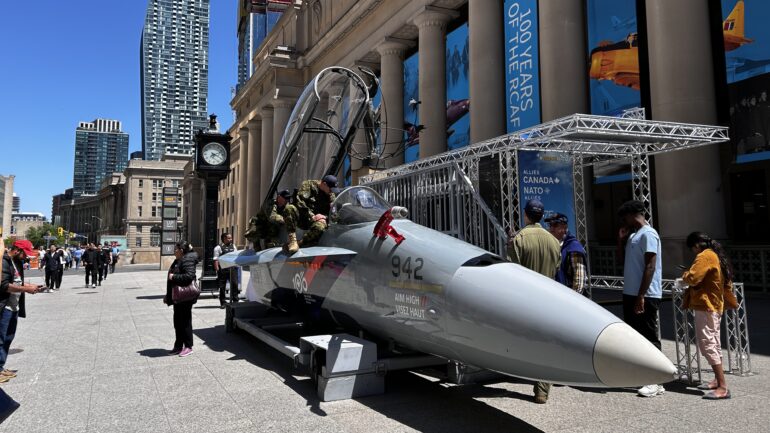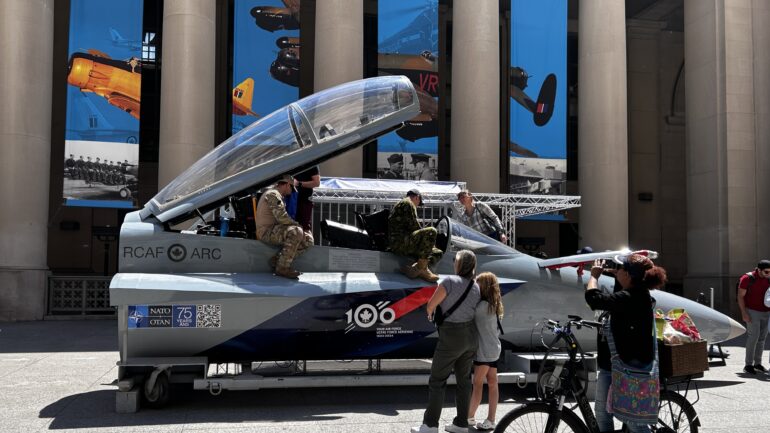The RCAF Foundation collaborated with Union Station to install an exhibit of a real CF-18 Hornet’s cockpit on Front Street until Sunday, June 2, 2024, to celebrate the Royal Canadian Air Force’s 100 years.
The CF-18 is a multi-role fighter jet and is RCAF’s current workhorse for air defence, ground attack, tactical support, aerobatic demonstration and aerospace testing and evaluation.
The Canadian government announced in 2023 that the CF-18 would be replaced by Lockheed Martin’s F-35A, after being in service for more than 40 years. The aged jet was used for combat missions including in Bosnia and Herzegovina. the First Gulf War and against ISIS in Syria and Iraq.
No CF-18s were lost during combat but 19 had crashed in crashes.
The exhibit allows visitors to experience sitting in a CF-18 and learn about the machine. The multi-role fighter can reach speeds of Mach 1.8 and has a range of about 3,700 kilometres.
The inside of the CF-18 Hornet is an exhilarating experience, offering civilians an abundance of switches, controls and navigation devices.
The seat is compact and the roof is dome shaped to aid in the aerodynamics of the jet. The cockpit is surrounded by switches on all three sides, with the throttle on the left and the control stick in the centre.
The pilots use the control stick and the pedals to maneuver the jet. The control stick also contains the switches for weapons used in air warfare.
The RCAF Foundation, although not a military operation, supports the Air Force, helps create content on multiple online platforms, devises scholarships for youth and brings public activations and installations in different cities across Canada.
The RCAF took off in 1914 as the Canadian Aviation Corps during the First World War. Four years later, the Canadian Air Force was formed in England and was attached to the Royal Air Force. It was renamed the Royal Canadian Air Force in 1924 with the addition of Royal approved by King Geoge V.
It became the Canadian Forces Air Command when the forces unified in 1968, and was renamed the RCAF in 2011.
Jeremy Diamond, the CEO of RCAF Foundation, said the idea of installing this exhibit was to educate the people of Toronto about the history of the Air Force.
“We wanted to try and bring the Air Force out to the people in a public space, where people can learn a little bit more about the history of the Air Force, but also how to potentially get involved in the Air Force. Especially if they’re young,” Diamond said.
The idea was to let people see what it felt like to be in the movie Top Gun for a moment so that it would lead to them learning about how to get involved with the RCAF, he said.
“You can’t go inside the cockpit of a fighter jet unless it is brought out to a space like Union Station,” Diamond said.
He said the idea to install the F-18 stemmed from the fact that the RCAF doesn’t have much of a presence in Toronto, due to not having a wing nearby.
Major Mark Regan, the deputy team lead for the RCAF Attractions Section, said the Air Force wanted to celebrate its history by showing people what it was like to be in a real fighter jet.
“It’ll be a big transition because we have other tech that we are onboarding. And that’s from drone technology to command and control to radars to NORAD modernization,” Regan said. “We have lots of things going on within the next five to ten years, and it’s a fascinating transition for the Air Force.”

The RCAF brought out a real CF-18 fighter jet cockpit for visitors to experience. Photo credit: Aarjavee Raaj
The Canadian Forces Recruiting Centre [CFRC] of Southern Ontario is also a part of the venture.
Captain Jevin Jeyaveerasingam, a military career counsellor with CFRC Toronto, said they are letting people know about careers in the Royal Canadian Air Force along with the outreach event.
“We’re just trying to let people know about different entry plans that we have in the Canadian Air Forces, [the] occupation streams and [the] different occupations you can do,” Jeyaveerasingam said.

Visitors flock around the CF-18, waiting for their turn to board onto the jet. Photo credit: Aarjavee Raaj
According to a press release from the RCAF Foundation, the CF-18 fleet is still in service with the RCAF, around 88 fighter jets are based in Bagotville, Que. and Cold Lake, Alta.


